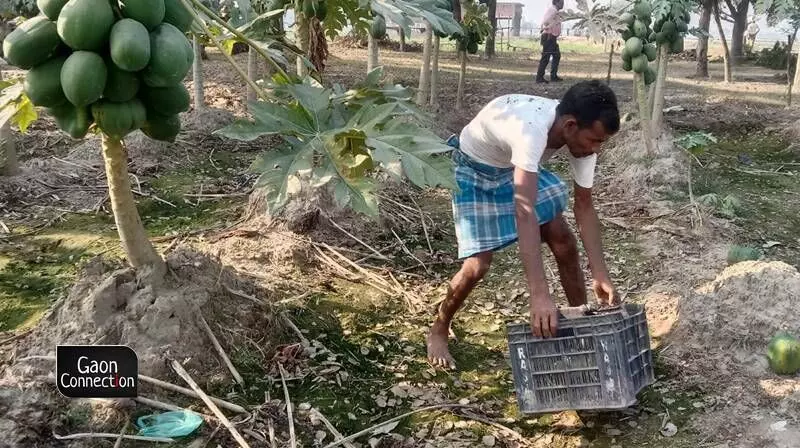Virus Alert: Papayas in Barabanki and Sitapur succumb to a ringspot virus
Papaya cultivation in Barabanki and Sitapur districts of Uttar Pradesh takes a hit as the ringspot virus affects the crop. The yield has been only one fourth of what it should be, complain the farmers. They blame changing climate for such large scale losses.
 Virendra Singh 7 Jan 2023 9:00 AM GMT
Virendra Singh 7 Jan 2023 9:00 AM GMT

The crop safety officer has advised against growing the same crop again and again on the same piece of land. All photos by Virendra Singh
Barabanki and Sitapur, Uttar Pradesh
There is consternation amongst the farmers in Barabanki district as a virus has ruined their papaya crop this year.
“I have made good profits from the papayas for five years now, but for the first time since I started cultivating the fruit, I have faced immense losses,” Maulana Irfan, a farmer from Mahadeva village on the banks of the Ghaghra river in Barabanki district, told Gaon Connection.
According to the 55-year-old Irfan, usually, each sapling of papaya yields anything up to a 100 kilograms of fruit. “This time I only got about 25 kilo of fruit per tree. Half my produce rotted away while the other half became infested,” the beleaguered farmer, who farms on two acres of land, said.
A little more than a 100 kilometres away, in Sitapur district, it is the same tale of woe. Pankaj Singh of Keshavpur village, who has cultivated papayas for the past three years in one acre of land is distraught. “I had to destroy my own crop as the virus had taken over completely. I have lost my entire investment on the crop this year,” he lamented.
Pankaj had planted the papayas in February. “I was looking forward to the usual bumper produce of papayas between October and December. But in July, my entire crop was wiped out,” he told Gaon Connection.
The changing climate is the reason why this has happened, papaya farmers in Barabanki and Sitapur said. This year the summers were hotter than usual and that was followed by unprecedented rains. “This onslaught of weather vagaries weakened the crops which then became vulnerable to the ringspot virus. We could get only one fourth of our produce,” Irfan said.
Also Read: UP: Unnao's first women-led SHG for Thai guava cultivation promises better incomes for farmers
Papaya ringspot virus
Papaya ringspot virus, or PRSV, infects papaya and cucurbits (cucumber, melons, pumpkin, squash and zucchini). Leaves become mottled with intense yellow and green patterns (known as mosaics); they are also distorted and much smaller than normal. Older leaves show dark green streaks on the leaf stalks.
Characteristic ringspots develop on the fruits. Plants may be stunted with fewer fruits than normal, but they rarely die from infection. The disease affects the flavour of the fruit.
Continuous use of the same pesticide is harmful to the plant too as the pests get used to it and the pesticide ceases to be effective.
The ringspot virus is not uncommon in papaya plants, said Manoj Singh, another farmer from Khajri village in Barabanki district. “I have been cultivating papayas for three years, and maybe two or three plants are affected by the virus each year. Nothing more. But this time the loss has been a lot more,” 45-year-old Manoj, told Gaon Connection. The leaves of the plant withered away and there was arrested growth, he said.
Also Read: Mango production in India to be hit due to early arrival of heatwaves
There are about 30 hectares of land under papaya cultivation in Barabanki, said Ganesh Chandra Mishra, its district horticulture office. “One acre of land can hold about 1,000 papaya saplings. And, each sapling can yield up to one quintal of fruit,” he told Gaon Connection. According to him, if the conditions were favourable, an acre of land could yield up to 800 quintals of fruit, he said.
“But, this time because of the vagaries of weather due to climate change, and the virus infestation, papaya production has been hit,” he acknowledged.
Irfan who also has a nursery for the papayas and sells saplings to other farmers from Barabanki, Sitapur and Lakhimpur Kheri said he had received a barrage of complaints from them, saying their crops were damaged on account of the virus.
Characteristic ringspots develop on the fruits. Plants may be stunted with fewer fruits than normal, but they rarely die from infection. The disease affects the flavour of the fruit.
How to save your papaya crop
The papaya is a very sensitive plant, pointed out AK Mishra, crop safety expert, based in Barabanki. “Too much water can damage it. So those farmers who are cultivating it on a small scale, should try an easy way to prevent over-watering. Hang a bottle with a litre of water near the sapling and allow water from it to drip gradually on the sapling over three days,” he advised.
He also said that continuous use of the same pesticide is harmful to the plant too as the pests get used to it and the pesticide ceases to be effective, and therefore provides no protection to the plant.
“While there is no real medicine for the virus, there is a fly that carries the infection from one sapling to another. Care should be taken to exterminate these flies at the time of using pesticides,” he said.
Also Read: After untimely rains and hailstorm, coronavirus lockdown leaves mango farmers in a fix
The crop safety officer also advised against growing the same crop again and again on the same piece of land. “That is an invitation to pests and viruses,” Mishra warned. The yield also decreases, he added.
#papaya farming Papaya Barabanki Uttar Pradesh
More Stories




